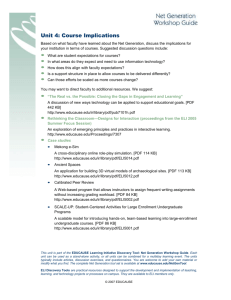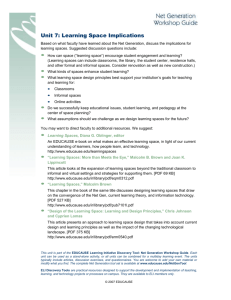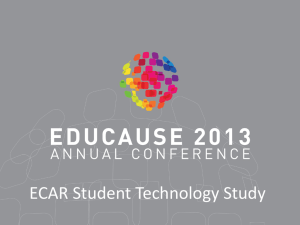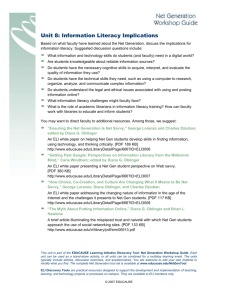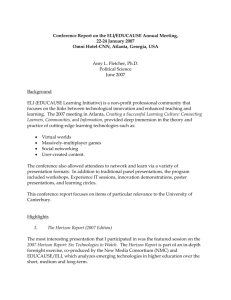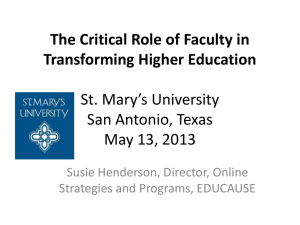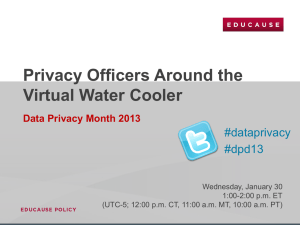Additional Resources
advertisement
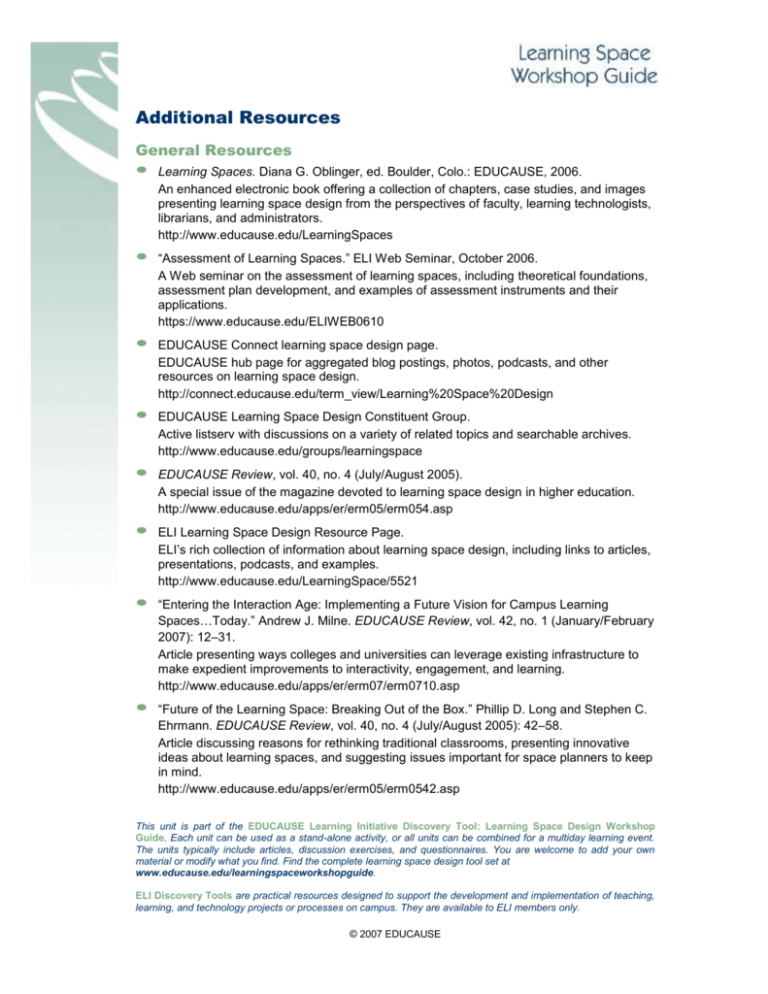
Additional Resources General Resources Learning Spaces. Diana G. Oblinger, ed. Boulder, Colo.: EDUCAUSE, 2006. An enhanced electronic book offering a collection of chapters, case studies, and images presenting learning space design from the perspectives of faculty, learning technologists, librarians, and administrators. http://www.educause.edu/LearningSpaces “Assessment of Learning Spaces.” ELI Web Seminar, October 2006. A Web seminar on the assessment of learning spaces, including theoretical foundations, assessment plan development, and examples of assessment instruments and their applications. https://www.educause.edu/ELIWEB0610 EDUCAUSE Connect learning space design page. EDUCAUSE hub page for aggregated blog postings, photos, podcasts, and other resources on learning space design. http://connect.educause.edu/term_view/Learning%20Space%20Design EDUCAUSE Learning Space Design Constituent Group. Active listserv with discussions on a variety of related topics and searchable archives. http://www.educause.edu/groups/learningspace EDUCAUSE Review, vol. 40, no. 4 (July/August 2005). A special issue of the magazine devoted to learning space design in higher education. http://www.educause.edu/apps/er/erm05/erm054.asp ELI Learning Space Design Resource Page. ELI’s rich collection of information about learning space design, including links to articles, presentations, podcasts, and examples. http://www.educause.edu/LearningSpace/5521 “Entering the Interaction Age: Implementing a Future Vision for Campus Learning Spaces…Today.” Andrew J. Milne. EDUCAUSE Review, vol. 42, no. 1 (January/February 2007): 12–31. Article presenting ways colleges and universities can leverage existing infrastructure to make expedient improvements to interactivity, engagement, and learning. http://www.educause.edu/apps/er/erm07/erm0710.asp “Future of the Learning Space: Breaking Out of the Box.” Phillip D. Long and Stephen C. Ehrmann. EDUCAUSE Review, vol. 40, no. 4 (July/August 2005): 42–58. Article discussing reasons for rethinking traditional classrooms, presenting innovative ideas about learning spaces, and suggesting issues important for space planners to keep in mind. http://www.educause.edu/apps/er/erm05/erm0542.asp This unit is part of the EDUCAUSE Learning Initiative Discovery Tool: Learning Space Design Workshop Guide. Each unit can be used as a stand-alone activity, or all units can be combined for a multiday learning event. The units typically include articles, discussion exercises, and questionnaires. You are welcome to add your own material or modify what you find. Find the complete learning space design tool set at www.educause.edu/learningspaceworkshopguide. ELI Discovery Tools are practical resources designed to support the development and implementation of teaching, learning, and technology projects or processes on campus. They are available to ELI members only. © 2007 EDUCAUSE Additional Resources “Learning Space Design Interview with Bill Dittoe.” Diana G. Oblinger. Podcast from the ELI Fall Focus Session, September 2005 Podcast of an interview with a founding member of Educational Facilities Consultants, a firm that helps colleges and universities develop learner-centered designs. http://connect.educause.edu/blog/dianao/learning_space_design_interview_with_bill_ dittoe/1288 Learning Space Design Resources. A resource page from the Society of College and University Planning (SCUP) offering information about resources and upcoming events. http://www.scup.org/resources/topic_issue/learning-space-dsgn.html Libraries Designed for Learning. Scott Bennett. Washington, D.C.: Council on Library and Information Resources, 2003. A research report that explores whether library projects completed in the 1990s have met the needs of students and faculty on campuses today. http://www.clir.org/pubs/execsum/sum122.html “The Next Generation of Digital Learning Spaces: Exploring the Frontier of Virtual Worlds.” Laurence F. Johnson, Alan Levine, and Heidi Trotta. Presentation at the ELI Annual Meeting, January 2007. Presentation plus additional resources on using virtual worlds as learning spaces. http://www.educause.edu/LibraryDetailPage/666?ID=ELI07163 Proceedings from the ELI Fall Focus Session 2005, “Design of Informal Learning Spaces.” Includes presentations on the kinds of informal settings that promote interaction and collaboration, enabling students to continue learning outside the classroom. http://www.educause.edu/eli054 Proceedings from the ELI Summer Focus Session 2005, “Rethinking the Classroom: Designs for Interaction.” Proceedings from a conference exploring emerging principles and practices in interactive learning and ways institutions can enhance their learning environments. http://www.educause.edu/Proceedings/7307 Proceedings from the NLII Fall Focus Session 2004, “Learning Space Design for the 21st Century.” Presentations from an NLII event that explored learning space design principles and their role in enhancing and transforming teaching and learning with technology. http://www.educause.edu/2004FallFocusSession/5602 Report from “Learning Space Design: Evolution or Revolution.” Proceedings from a conference on learning space design offered by the Joint Information Systems Committee (JISC) Regional Support Centre London. http://www.rsc-london.ac.uk/763/ Principles of Learning and Design “Flexible Space & Built Pedagogy: Emerging IT Embodiments.” Torin Monahan. Inventio, vol. 4, no. 1: 1–19. Explores the juncture of information technology infrastructures and traditional educational spaces and proposes flexible criteria for hybrid learning environments. http://connect.educause.edu/library/abstract/FlexibleSpaceBuiltPe/36368 2 Additional Resources How People Learn: Bridging Research and Practice. National Research Council. M. Suzanne Donovan, John D. Bransford, James W. Pellegrino, eds. Washington, D.C.: National Academies Press, 1999. Offers ways to bridge scientific research on learning and practical pedagogical approaches. http://books.nap.edu/html/howpeople2/ The Importance of Physical Space in Creating Supportive Learning Environments. Nancy Van Note Chism and Deborah J. Bickford, eds. New York: John Wiley & Sons, 2002. Book focused on aligning what is known about the importance of physical space and practical learning space design, offering multiple perspectives from leading thinkers and practitioners. http://spacesforlearning.udayton.edu/ In Sync: Environmental Behavior Research and the Design of Learning Spaces. Lennie Scott-Webber. Ann Arbor, Mich.: Society for College and University Planning, 2004. Book examining behavioral and sociological research relating to how people interact with the built environment and considering the implications for learning space design. http://www.scup.org/pubs/books/is_ebrdls.html “Principles of Learning Space Design Illustrated by Case Studies.” Malcolm B. Brown, Dan Gilbert, Christopher G. Johnson, and Phillip D. Long. Presentation at the NLII Fall Focus Session, September 2004. Set of presentations reviewing important principles in designing spaces for learning and linking them to real examples. http://www.educause.edu/librarydetailpage/666?id=nli0440 Students and Learning Spaces ELI Discovery Tool: Student Input on Learning Spaces. Activity that provides a structured yet creative way of seeing one’s campus as one’s students do, to more effectively plan and design institutional learning spaces. http://www.educause.edu/LibraryDetailPage/666?ID=ELI8001 “The Information Commons: Adapting to the Culture of Net Generation Students.” Proceedings from the Academic Libraries 2005 conference (Saratoga Springs, New York), which focused on Net Generation students and the information commons. http://www.ny3rs.org/al2005.html “Solutions to Digital Discontent: Place and Presence.” James B. Kerkhoff and Carole Turner. Presentation at the ELI Annual Meeting, January 2007. Presentation looking at the gaps between student expectations and university offerings, especially in the area of learning spaces. http://www.educause.edu/LibraryDetailPage/666?ID=ELI07180 3 Additional Resources Case Studies and Examples Collaborative Facilities Project. Online clearinghouse of information about model collaborative facilities in higher education sponsored by the Coalition for Networked Information and hosted by Dartmouth College. http://www.dartmouth.edu/~collab Designing Learning Spaces That Promote Engagement. Web page offering resources related to Estrella Mountain Community College’s Learning Studios project. http://www.estrellamountain.edu/awareness/studio.asp DesignShare Case Studies of Higher Education Award Winners. Web page offering snapshots of U.S. and international institutions that have won innovative learning space design awards, including costs, plans, and images. http://www.designshare.com/index.php/awards/higher-education “Setting the Stage for Academic Engagement: Reengineering a Georgia Tech Library.” Crit Stuart. Presentation at the ELI Annual Meeting, January 2007. Presentation offering a look at the redesigned Crosland Library at Georgia Tech. http://www.educause.edu/LibraryDetailPage/666?ID=ELI07160 Spaces for Learning: A Review of Learning Spaces in Further and Higher Education. Edinburgh, Scotland: Scottish Funding Council, 2006. Scottish report about applying research on effective learning and student-centered approaches to learning facilities, supplemented with photos, case studies, and appendices on trends in learning and technology. http://www.jiscinfonet.ac.uk/Resources/external-resources/sfc-spaces-for-learning World Class Buildings: Design Quality in Further Education. Coventry, England: Learning and Skills Council, 2005. Booklet spotlighting 12 principles of good learning space design complemented by matching case studies and extensive photos. [PDF 1.4 MB] http://readingroom.lsc.gov.uk/lsc/2005/research/commissioned/world-class-buildings.pdf 4
